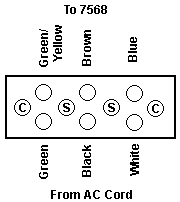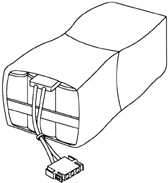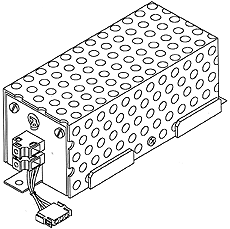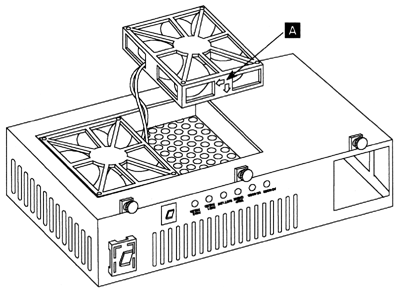Gearbox
Power Supply Supply
AC
Power Cord Hook-Up
Front
of Power Supply
Remove
PSU
Dead
PSU, or Is It Dead?
Status Light
Meanings
Power Supply Voltages
and Current
Nicad Battery
EVM Module
PSU Fan
Cleaning the PSU
Gearbox
Power
The GEARBOX Model 800 is a direct-wire
system, using a
customer-provided power cable to an applicable power
source. 300 total
watt worldwide, autoranging (will detect and switch for
120 or 220) power
supply, with two fans to assure system cooling.
AC
Power Cord
Hook-Up
 7568s wired for AC power have a terminal block mounted
on the
left side (or upper left rear corner). The black wire
(shield) on the system
side of the terminal DOES NOT
attach
to the terminal block.
7568s wired for AC power have a terminal block mounted
on the
left side (or upper left rear corner). The black wire
(shield) on the system
side of the terminal DOES NOT
attach
to the terminal block.
C - Terminal Cover screws
S - Terminal Block screws
Power Supply
(with EVM installed)

Remove
PSU
Turn power switch off on PSU. Unscrew the
three captive
screws on the bottom front edge. Grab on the cutout around
the EVM/Battery
pack on the left and grab the right corner of the PSU
(though you might
try the rightmost captive screw).
Note: If you pull the
rightmost shroud (#9) you can get a grip on the rear right
inner corner of the PSU....
Rock the PSU a little as you pull it
out. The plug is at the back of the PSU behind the power
switch. It resembles
a mutant 95 planar plug. Do NOT
grab
the black plastic guard around the power switch!!!
Dead
PSU or Is
It Really Dead?
I had two 7568s, one powered up, the other
didn't. Swapped
the PSUs, one worked in both cases, the other didn't
work at all. These
babies are built even heavier than a 95A PSU, so I was
puzzled.
Dr.Jim Shorney did the office call
and says:
The tabs holding the thumbscrews at the
bottom front of
the PS were tweaked backwards. Straightened them
out so the PS seated
fully.
Status Lights Meaning
| MAIN |
DC |
TEMP |
BATT |
FAN1 |
FAN2 |
Possible Problem |
| O |
X |
O |
O |
O |
O |
1. Mains power missing
2. Defective power supply |
| X |
O |
O |
O |
O |
O |
Defective Power Supply |
| X |
X |
X |
O |
O |
O |
1. Hi temp (poor ventilation?)
2. Defective power supply |
| X |
X |
O |
X |
O |
O |
1. Battery discharged or disconnected
2. Defective power supply |
| X |
X |
O |
O |
X |
O |
1. Fan 1 Malfunction
2. Defective power supply |
| X |
X |
O |
O |
O |
X |
1. Fan 2 malfunction
2. Defective power supply |
| X |
X |
O |
O |
O |
O |
MAINS OK - Power supply OK |
Standby Switch
Run position to the left, Standby to the
right. The Run-Standby
switch is used when the system is disconnected from AC
power for more than
72 hours. In the run mode, the battery (the big 5v 1F
capacitor on the
System Resource card) preserves the setup and
time-of-day clock for
72 hours. In standby, the battery preserves the setup
and time-of-day information
up to 60 days. Some special bid units lacked a standby
switch.
Warning! Do NOT
start the system
in Standby mode!!! Avoid turning on the system with no
AC power attached
when the internal battery is installed. This will
severely discharge the
Ni-Cad battery... (no foolin' !)
Power Source Choices
When the system is turned on, the PSU
senses the applied
power source. If AC power is present, the system starts
and runs with AC
as primary power. If DC power is present, it is used as
a backup power
source (requires EVM for extended backup time).
If no AC power is present, the system
starts and runs
off DC power, if DC power is available at the battery
connector (requires
EVM to be installed). There is no backup capability in
this configuration.
Don't try running system off battery pack!!!
The system sets operating mode (AC or DC)
when the system
is turned on. It remains in that mode until the power
switch is turned
off.
AC Specs
120 / 220
6.0A / 2.7A
Single phase.
Power usage .75KVA
AC Power Cable
Any cable used must be a minimum of 16AWG
with ground.
Power
Supply Values
Max output 288.8 W
+5V @42A -5V @0.3A
+12V @4A -12V @1A
+6V @5mA
Battery Charger +28V @80mA
Fan Supply 15W max
BATTERY,
NICAD
(INTERNAL) (#6221) (P/N 15F8625):

This internally mounted battery allows continuous
operation through
brief main power interruptions (nominal 1.5 seconds
default). Also, if
the interruption continues beyond this period, the
battery maintains DC
voltages to allow the system to perform an orderly
shutdown.
Note 1: Battery or
EVM must be installed
to retain system set up information during periods when
system is shut
down. (though there is a whopping big 5v 1F cap on the
system resource
board).
Note 2: Shutdown is
limited to max
of 10 sec under hardware control. Software control
shutdown depends on
the electrical load and the battery capacity, and may be
limited to 10
seconds. Longer shutdown periods require external
battery backup, which
requires an EVM.
The battery pack is 21 (twenty-one) Sony Cadnica KR-SCH
1.2v 1200mAh,
Standard charge14-16 hrs at 120mA, recommended trickle
charge 40mA.
Marked "Plainview Batteries, Inc" mfd- 9104 IBM
replacement PN
15F8625
EXTERNAL
VOLTAGE MODULES
(#6231 AND #6528):
 These EVM features
allow the connection of an external DC voltage source
either for additional
battery backup to the main AC power, or as a main DC
power source. No other
external voltages are to be used as a main source or as
a backup. These EVM features
allow the connection of an external DC voltage source
either for additional
battery backup to the main AC power, or as a main DC
power source. No other
external voltages are to be used as a main source or as
a backup.
EVM #6231 24 volts DC.
EVM #6528 48 or 60 volts DC.
Note: Either an EVM
(hooked to
an external DC voltage source), or internal nicad
battery
(#6221) must be installed to retain system set up
information
during periods when the system is shut down.
The EVM provides RFI filtering, reverse polarity
protection, and over
voltage protection.
Warning! A fully
populated Gearbox
requires up to 30A on the DC line. Use a minimum of
12AWG
PSU Fan
ETRI Model 98DW 98DW1LP31 203, 12v (8-15v) at
5.2W (under
.5A)
Filter Use
The 7568 can use optional filters in the
PSU compartment.
Use of filters degrades the maximum temperature
decreases by 9°F/5°C.
Changing Airflow Direction

Remove the PSU. Flip it upside down. If you
can see the
ETRI sticker on the fan hub, the PSU is set to blow down
through the shrouds.
This direction is used for the filter configuration.
Unfortunately, the
heat generated by the PSU is now blown through the
shrouds.
If you see a silver hub, the PSU is set to
suck air up
through the shrouds and out through the grilles in the
PSU compartment.
This is good because the heat from the PSU is not blown
through the populated
shrouds.
Remove the three standard screws in each
fan housing. Pull
them out and flip them over to whatever way you want. If
you are unsure
about the direction, there are two arrows embossed on
the fan housing,
showing fan rotation AND airflow direction.
Cleaning
the PSU
Hooray! I stumbled onto this working on the
fans...
At first look, it's grim. Rivets everywhere.
Don't give up. Flip
PSU upside-down. Unplug fan power connectors. Remove all
fan screws. Pull
up on grille and push the fan power connectors through
using a flat bladed
screwdriver. Now the grill comes off, and the majority
of the PSU components
are exposed.
Copper heatsinks! Stud power diodes!
|